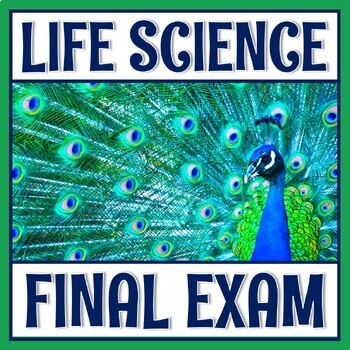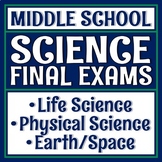Biology Life Science FINAL EXAM ASSESSMENT Middle School NGSS 2 Versions
Flying Colors Science
4.8k Followers
Grade Levels
6th - 8th
Subjects
Resource Type
Standards
NGSSMS-LS1-5
NGSSMS-LS1-7
NGSSMS-LS1-2
NGSSMS-LS2-2
NGSSMS-LS2-3
Formats Included
- PDF
Pages
11 pages
Flying Colors Science
4.8k Followers
Also included in
- SAVE MORE THAN 25% with this set of 10 middle school life science tests for every unit of the year!⭐ YOUR WORK IS DONE! This an entire year of summative assessments designed for 6th, 7th, and 8th-grade NGSS-aligned life science classes.⭐ Get kids THINKING! The tests in this collection are more thanPrice $29.99Original Price $42.44Save $12.45
- Never search for "something to do tomorrow" ever again! This bundle contains PRINT AND GO lessons, NO PREP activities, LOW PREP labs, and ENGAGING articles to supplement and thoroughly enhance a life science course. Every included resource is easy to implement, standards-based, and high-quality.Price $399.99Original Price $766.48Save $366.49
- BUY 2 GET 1 FREE! Includes 3 FINAL EXAMS for middle school science!Tests Included in Bundled Set:Life Science Final Exam (40 Questions, 2 versions)Physical Science Final Exam (50 Questions, 2 versions)Earth and Space Science Final Exam (50 Questions, 1 version)Each included test focuses on the essenPrice $9.99Original Price $14.97Save $4.98
Description
2 VERSIONS of a middle school LIFE SCIENCE PRE-ASSESSMENT or FINAL TEST! Both of these tests could also be used as a pretest or a DDM (District Determined Measure). They cover the same topics but have different levels of rigor.
⭐ Get this resource at a discount in our NGSS Science Final Exam Set.
Topics Include:
- Cells and organelles
- Generalizations about human body systems
- Photosynthesis and respiration (the basics)
- Ecosystems (energy roles and food webs)
- Asexual reproduction
- Sexual reproduction (including the basics of chromosomes & genetics)
- Natural selection
- Evidence for evolution
- Very basics of classification
NGSS Standards Covered:
MS-LS1-1, MS-LS1-2, MS-LS1-3, MS-LS1-4, MS-LS1-5, MS-LS1-6, MS-LS1-7, MS-LS1-8, MS-LS2-1, MS-LS2-2, MS-LS2-3, MS-LS2-4, MS-LS2-5, MS-LS3-1, MS-LS3-2, MS-LS4-1, MS-LS4-2, MS-LS4-3, MS-LS4-4, MS-LS4-5, MS-LS4-6
TEST VERSION A:
- This is not a "definition-style" test! This test focuses on the essential understandings of middle school life science topics. The questions are "big picture" in nature and mimic the way NGSS-based standardized tests generally ask about these topics. The questions include some simple diagrams and charts to analyze and require some thinking.
- 40 questions
- Less copies and easy to correct - save time with our test packet format! This version of the test has a test question packet (4 pages front/back) and a separate answer sheet (1 page). You only need to make one class set of copies of the test question packet because it can be reused class-to-class. Students ONLY write on their provided answer sheet.
TEST VERSION B:
- This is essentially a definitions and matching test.
- 33 questions
- Designed to be streamlined and easy to correct!
Teacher Notes:
- ANSWER KEYS ARE PROVIDED.
- Please note: These tests are NOT editable.
- Find a self-correcting GOOGLE FORMS VERSION of Test Version A HERE.
We also offer:
Total Pages
11 pages
Answer Key
Included
Teaching Duration
1 Year
Report this resource to TPT
Reported resources will be reviewed by our team. Report this resource to let us know if this resource violates TPT’s content guidelines.
Standards
to see state-specific standards (only available in the US).
NGSSMS-LS1-5
Construct a scientific explanation based on evidence for how environmental and genetic factors influence the growth of organisms. Examples of local environmental conditions could include availability of food, light, space, and water. Examples of genetic factors could include large breed cattle and species of grass affecting growth of organisms. Examples of evidence could include drought decreasing plant growth, fertilizer increasing plant growth, different varieties of plant seeds growing at different rates in different conditions, and fish growing larger in large ponds than they do in small ponds. Assessment does not include genetic mechanisms, gene regulation, or biochemical processes.
NGSSMS-LS1-7
Develop a model to describe how food is rearranged through chemical reactions forming new molecules that support growth and/or release energy as this matter moves through an organism. Emphasis is on describing that molecules are broken apart and put back together and that in this process, energy is released. Assessment does not include details of the chemical reactions for photosynthesis or respiration.
NGSSMS-LS1-2
Develop and use a model to describe the function of a cell as a whole and ways the parts of cells contribute to the function. Emphasis is on the cell functioning as a whole system and the primary role of identified parts of the cell, specifically the nucleus, chloroplasts, mitochondria, cell membrane, and cell wall. Assessment of organelle structure/function relationships is limited to the cell wall and cell membrane. Assessment of the function of the other organelles is limited to their relationship to the whole cell. Assessment does not include the biochemical function of cells or cell parts.
NGSSMS-LS2-2
Construct an explanation that predicts patterns of interactions among organisms across multiple ecosystems. Emphasis is on predicting consistent patterns of interactions in different ecosystems in terms of the relationships among and between organisms and abiotic components of ecosystems. Examples of types of interactions could include competitive, predatory, and mutually beneficial.
NGSSMS-LS2-3
Develop a model to describe the cycling of matter and flow of energy among living and nonliving parts of an ecosystem. Emphasis is on describing the conservation of matter and flow of energy into and out of various ecosystems, and on defining the boundaries of the system. Assessment does not include the use of chemical reactions to describe the processes.








